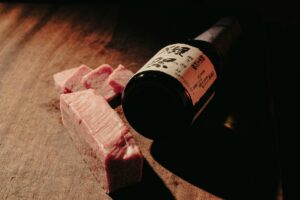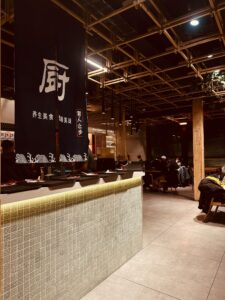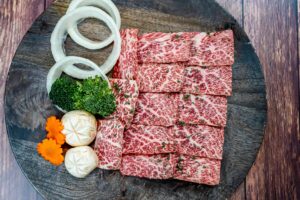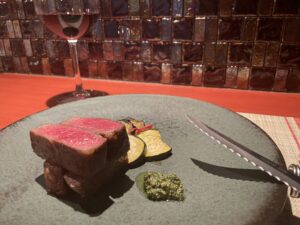How to Book a Wagyu Course in Tokyo: Step-by-Step

A neutral, English-friendly guide with a real-life reservation example
If you’re trying to figure out how to book Wagyu in Tokyo without speaking Japanese, you’re not alone. This guide explains the key steps—plus an example from a real restaurant—to help you plan with confidence.
Not All Wagyu Is the Same
In Japan, “Wagyu” is a widely recognized term—but not all Wagyu is created equal.
Many restaurants, including large chain establishments, now offer Wagyu on their menus. However, there are major differences in quality, grading, and sourcing. Some serve A5-ranked Kuroge (black-haired) beef known for its intense marbling, while others use lower-grade or imported Wagyu. There are also rare breeds like Kumamoto Akaushi (red-haired Wagyu), which are leaner, richer in flavor, and harder to find.
Just because it says “Wagyu” doesn’t mean it’s the same. The origin, breed, and preparation all make a huge difference in taste, texture, and value.
This guide shows how to book Wagyu in Tokyo through a real example, so you can enjoy your meal without stress or language issues.

In Tokyo’s competitive food scene, many travelers arrive with one goal: to try authentic Japanese Wagyu. But something interesting is happening—more Tokyo travelers
Why You Should Book
Wagyu in Tokyo in Advance

In recent years, Japan’s dining scene has shifted toward small, chef-driven restaurants that specialize in Wagyu and other high-quality seasonal ingredients. These places often serve only a handful of guests each evening, focusing on a carefully prepared course menu.
In Tokyo’s most popular areas—like Shinjuku, Shibuya, Ikebukuro, Asakusa, Ueno, and central Tokyo—restaurants are frequently packed with both locals and international visitors. With Japan’s dense population and high restaurant-to-land ratio, seats go quickly, especially at small, high-end venues.
That’s why making a reservation is not just helpful—it’s essential. Many of the best places are booked days in advance. If you want a quieter, more personal Wagyu experience, it helps to plan ahead and avoid the typical tourist routes.
How to Book Wagyu in Tokyo
in English

Thanks to Japan’s growing inbound tourism, many high-end restaurants are now easier for English speakers to book—especially those used to serving international guests.
That said, phone reservations can still be tricky. Many staff members don’t speak fluent English, and phone calls can lead to miscommunication or awkward interactions. It’s not uncommon for both sides to feel stressed.
Online reservations are the new standard. They allow you to clearly input your desired time, number of guests, allergies, and other details without language issues. If a restaurant offers English-enabled online booking, it’s often a sign that they are prepared to serve international guests comfortably.
If a restaurant only offers a phone number or a Japanese-only form, it may be difficult to book without help. Stick to places with online booking options in English or platforms like TableCheck, Square, or Pocket Concierge.
How a Tokyo Wagyu Restaurant
Handles Reservations

To help you understand how to book Wagyu in Tokyo in real life, here’s how one restaurant—QUNIOMI in Ebisu—handles reservations.
QUNIOMI is a small restaurant that serves rare lean Wagyu (Kumamoto Akaushi) in a French-inspired seasonal tasting course. It does not use marbled black Wagyu, but instead focuses on flavor-rich, clean-tasting red Wagyu, sourced directly through long-term relationships.
Here is how booking works at QUNIOMI:
- Visit the reservation page and fill out the request form.
https://lp.nikuebisu.com/reservation-en/ - Enter your preferred date and time, number of guests, email address, and any dietary requests or celebration notes.
- Within 24 hours, the restaurant will reply by email to confirm whether your requested time is available.
- If available, the email will include a link to pay a ¥4,000 deposit per person via Square.
- Once you complete the deposit payment, your booking is confirmed.
Please note: submitting the reservation form alone does not guarantee a booking. Only after receiving and paying the deposit link is the reservation secured.
What to Prepare Before Booking
To avoid delays, have the following ready:
- Number of guests
- Preferred date and time
- A working email address (double-check for typos)
- Any allergy information or special requests
- Optional message (e.g. “honeymoon dinner” or “birthday”)
Deposits are common at high-end restaurants in Japan, especially for limited-seat dining. At QUNIOMI, the deposit is ¥4,000 per person, paid securely via credit card with no account required.
Cancellation and Modification Policy
Every restaurant has its own rules. Be sure to read the fine print.
At QUNIOMI, reservations can be canceled or changed free of charge up to 48 hours before your booking time. After that point, the deposit is non-refundable.
This policy is designed to protect the restaurant from last-minute cancellations, while still giving travelers some flexibility—even after arriving in Japan.
Booking Mistakes to Avoid in Japan

Here are some of the most common mistakes travelers make when booking restaurants in Japan—and how to avoid them:
- Not researching the restaurant properly:
Japan has an overwhelming number of dining options. Without checking in advance, you may end up at a place that doesn’t specialize in high-quality Wagyu or is already fully booked. - Trying to find a restaurant after arriving:
Walking around to find a place on the spot often leads to decision fatigue and disappointment. Popular restaurants fill up fast. - Assuming booking culture is the same as at home:
In Japan, reservations are often required for course-based restaurants—even if the place looks empty. - Underestimating the language barrier:
English may not be widely spoken. Online systems reduce friction and help ensure accuracy.
You don’t need to be afraid—just be prepared. Booking from abroad, in English, using a clear online form, is often the smoothest and least stressful path.
Summary: How to Book
Wagyu in Tokyo
Booking a proper Wagyu course in Tokyo is not difficult—but it does require planning and care. Avoid chain restaurants with vague Wagyu sourcing, and look for course-based restaurants that focus on quality and guest experience.
This article was written to help travelers understand how to book Wagyu in Tokyo—clearly, safely, and without confusion.
Want to see how a real restaurant handles reservations?
👉 Visit the official reservation page here
Want more? The full booking guide
🔎 Want to go even further?
Discover how to choose the right Wagyu restaurant, avoid tourist traps, and make your Tokyo trip unforgettable:
👉The Complete Guide to Booking Wagyu in Tokyo 2025 Edition